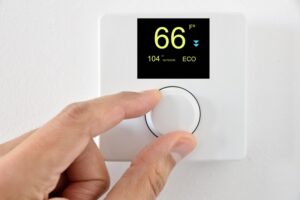
People often misunderstand how thermostats for home HVAC systems work. They’ll adjust the settings up and down on a whim based on their current comfort, assuming the heater or AC will just shift to accommodate. But using a thermostat this way is almost guaranteed to deliver…
- Less comfort
- Higher bills
- An HVAC system that needs too many repairs and fails early
Setting the thermostat to help you save money and enjoy comfort this winter isn’t some tricky artform—it’s only a set of best practices you can easily follow once you know how the thermostat and the heating system work together.
Below, we’re going to pass on our wisdom as HVAC experts to help you have great heating in Akron, OH this winter.
The Steady Thermostat Setting Is the Winning Setting
The common mistake people make about thermostat operation is thinking that a thermostat works like a throttle: the more you press it down, the more energy you get back. Want faster heating in your house? Press down that “pedal” on the thermostat and send it up as high as you need it. Too hot now? Let your foot off the “gas” by lowering the thermostat setting.
A thermostat, however, is not a throttle. It’s a switch. It determines when the heating system and blower fan turn on and off. When you set the thermostat, you’re telling the heating system to stay on for as long as necessary to reach the temperature setting. Raising the setting only makes the heater run longer—it doesn’t produce more heat or work faster.
Since a thermostat isn’t a throttle, it’s best to keep it at a steady setting: one for during the day when people are home, and one for the evening or when the house is empty. This prevents the heating system from going through constant stops and starts that drain power and put immense strain on its parts. It also prevents your house from shifting from “too hot” to “too cold.”
Lower the Thermostat, Don’t Raise It
What are the best settings for your thermostat? We recommend keeping the setting low during both day and night. For the daytime, 68°F is ideal. At night or when the house is empty, lower the setting by a further 8° to 10°.
The reason for the lower setting is not only to conserve energy. It slows down how fast your house loses heat, and that makes it easier to stay warm. The hotter the inside of your house, the faster that heat will escape outdoors. A setting of 68°F is comfortable for most people wearing warm clothing, and it helps the house retain its heat. Just lowering the thermostat average during the day from 72°F to 68°F can reduce your winter heating bills by 5%.
If you think 68°F is too cold, raise the setting a few degrees until you find a comfortable setting. Then lower the thermostat by one degree each day until you get to 68°F. This will acclimatize the household to the new setting.
Crown Group Ohio serves Stark and Summit Counties. Your Comfort Experts Since 1963—call us when you need help with your home comfort.
